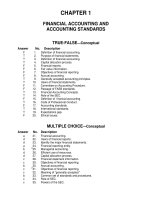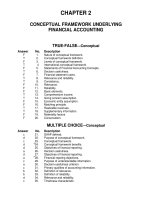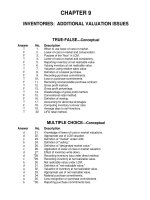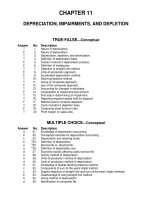Intermediate accounting 16e by kieso slide ch11
Bạn đang xem bản rút gọn của tài liệu. Xem và tải ngay bản đầy đủ của tài liệu tại đây (4.25 MB, 79 trang )
11-1
PREVIEW OF CHAPTER 11
Intermediate Accounting
16th Edition
Kieso ● Weygandt ● Warfield
11-2
11
Depreciation, Impairments, and Depletion
LEARNING OBJECTIVES
After studying this chapter, you should be able to:
1
Understand depreciation concepts and methods of
4
depreciation.
2
Explain special depreciation methods and other
depreciation issues.
3
Explain the accounting procedures for depletion of
natural resources.
5
Explain how to report and analyze property, plant,
equipment, and natural resources.
Explain the accounting issues related to asset
impairment.
11-3
LO 1
DEPRECIATION—METHOD OF COST ALLOCATION
Depreciation is the accounting process of allocating the cost of tangible assets to expense in a
systematic and rational manner to those periods expected to benefit from the use of the asset.
Allocating costs of long-lived assets:
11-4
Fixed assets = Depreciation expense
Intangibles = Amortization expense
Natural resources = Depletion expense
LO 1
METHOD OF COST ALLOCATION
Factors Involved in the Depreciation Process
Three basic questions:
11-5
(1)
What depreciable base is to be used?
(2)
What is the asset’s useful life?
(3)
What method of cost apportionment is best for this asset?
LO 1
METHOD OF COST ALLOCATION
Factors Involved in the Depreciation Process
Depreciable Base for the Asset
ILLUSTRATION 11-1
Computation of Depreciation Base
11-6
LO 1
METHOD OF COST ALLOCATION
Factors Involved in the Depreciation Process
Estimation of Service Lives
11-7
Service life often differs from physical life.
Companies retire assets for two reasons:
1.
Physical factors (casualty or expiration of physical life).
2.
Economic factors (inadequacy, supersession, and obsolescence).
LO 1
WHAT DO THE NUMBERS MEAN?
WHAT’S YOUR PRINCIPLE
ALPHEBET DUPE
Some companies try to imply that depreciation is not a cost. For example, in their press releases they will often make a bigger deal over
earnings before interest, taxes, depreciation, and amortization (often referred to as EBITDA) than net income under GAAP. They like it
because it “dresses up” their earnings numbers. Some on Wall Street buy this hype because they don’t like the allocations that are
required to determine net income. Some banks, without batting an eyelash, even let companies base their loan covenants on EBITDA.
For example, look at Premier Parks, which operates the Six Flags chain of amusement parks. Premier touts its EBITDA performance.
But that number masks a big part of how the company operates—and how it spends its money. Premier argues that analysts should
ignore depreciation for big-ticket items like roller coasters because the rides have a long life. Critics, however, say that the amusement
industry has to spend as much as 50 percent of its EBITDA just to keep its rides and attractions current. Those expenses are not
optional—let the rides get a little rusty, and ticket sales start to tail off. That means analysts really should view depreciation associated
with the costs of maintaining the rides (or buying new ones) as an everyday expense.
11-8
(continued)
LO 1
WHAT DO THE NUMBERS MEAN?
WHAT’S YOUR PRINCIPLE
ALPHEBET DUPE
It also means investors in those companies should have strong stomachs. What’s the risk of trusting a fad accounting measure? Just
look at one year’s bankruptcy numbers. Of the 147 companies tracked by Moody’s that defaulted on their debt, most borrowed money
based on EBITDA performance. The bankers in those deals probably wish they had looked at a few other factors. On the other hand,
nonfinancial companies in the S&P 500 recently generated a substantial EBITDA margin of 20.9 percent. Some analysts are concerned
that such a high number suggests that companies are reluctant to incur costs and want to stockpile cash. The lesson? Investors will do
well to avoid focus on any single accounting measure.
Sources: Adapted from Herb Greenberg, “Alphabet Dupe: Why EBITDA Falls Short,” Fortune (July 10, 2000), p. 240; and V. Monga, “Operating Efficiency Runs High at U.S.
Firms,” Wall Street Journal (February 28, 2012), p. B7.
11-9
LO 1
METHOD OF COST ALLOCATION
Methods of Depreciation
The profession requires the method employed be “systematic and rational.” Methods
used include:
11-10
1.
Activity method (units of use or production).
2.
Straight-line method.
3.
Sum-of-the-years’-digits.
Decreasing charge methods
4.
Declining-balance method.
5.
Group and composite methods.
6.
Hybrid or combination methods.
Special methods
LO 1
METHOD OF COST ALLOCATION
Activity Method
Illustration 11-2
Data Used to Illustrate Depreciation
Methods
Stanley Coal Mines Facts
Illustration: If Stanley uses the crane for 4,000 hours the first year, the depreciation charge is:
Illustration 11-3
Depreciation Calculation, Activity Method—Crane
Example
11-11
LO 1
METHOD OF COST ALLOCATION
Straight-Line Method
Illustration 11-2
Data Used to Illustrate Depreciation
Methods
Stanley Coal Mines Facts
Illustration: Stanley computes depreciation as follows:
Illustration 11-4
Depreciation Calculation, Straight-Line Method— Crane Example
11-12
LO 1
METHOD OF COST ALLOCATION
Decreasing-Charge Methods
Illustration 11-2
Data Used to Illustrate Depreciation
Methods
Stanley Coal Mines Facts
Sum-of-the-Years’-Digits. Each fraction uses the sum of the years as a denominator (5 + 4 + 3 + 2 + 1 = 15).
The numerator is the number of years of estimated life remaining as of the beginning of the year.
Alternate sum-of-the-years’ calculation
n(n+1)
=
=
2
11-13
5(5+1)
15
2
LO 1
METHOD OF COST ALLOCATION
Sum-of-the-Years’-Digits
Illustration 11-6
Sum-of-the-Years’-Digits Depreciation Schedule— Crane Example
11-14
LO 1
METHOD OF COST ALLOCATION
Decreasing-Charge Methods
Illustration 11-2
Data Used to Illustrate Depreciation
Methods
Stanley Coal Mines Facts
Declining-Balance Method
11-15
Utilizes a depreciation rate (percentage) that is some multiple of the straight-line method.
Does not deduct the salvage value in computing the depreciation base.
LO 1
METHOD OF COST ALLOCATION
Declining-Balance Method
Illustration 11-7
Double-Declining Depreciation Schedule— Crane Example
11-16
LO 1
METHOD OF COST ALLOCATION
Illustration—(Four Methods): Maserati Corporation purchased a new machine for its assembly process on August 1,
2017. The cost of this machine was $150,000. The company estimated that the machine would have a salvage value
of $24,000 at the end of its service life. Its life is estimated at 5 years and its working hours are estimated at 21,000
hours. Year-end is December 31.
Instructions: Compute the depreciation expense under the following methods.
(a) Straight-line depreciation.
(b) Activity method (d)
11-17
(c)
Sum-of-the-years’-digits.
Double-declining balance.
LO 1
METHOD OF COST ALLOCATION
Straight-line Method
11-18
LO 1
METHOD OF COST ALLOCATION
Activity Method
11-19
(Assume 800 hours used in 2017)
LO 1
METHOD OF COST ALLOCATION
Sum-of-the-Years’-Digits Method
11-20
5/12 = .41667
7/12 = .58333
LO 1
METHOD OF COST ALLOCATION
Double-Declining Balance Method
11-21
LO 1
11
Depreciation, Impairments, and Depletion
LEARNING OBJECTIVES
After studying this chapter, you should be able to:
1
Understand depreciation concepts and methods of
4
depreciation.
2
Explain special depreciation methods and other
depreciation issues.
3
Explain the accounting procedures for depletion of
natural resources.
5
Explain how to report and analyze property, plant,
equipment, and natural resources.
Explain the accounting issues related to asset
impairment.
11-22
LO 2
SPECIAL DEPRECIATION METHODS AND OTHER ISSUES
Special Depreciation Methods
Two methods of depreciating multiple-asset accounts exist:
Group method used when the assets are similar in nature and have approximately the same useful
lives.
Composite method used when the assets are dissimilar and have different lives.
The choice of method depends on the nature of the assets involved.
The computation for group or composite methods is essentially the same: find an average and depreciate on that basis.
11-23
LO 2
Group and Composite Methods
Illustration: Mooney Motors establishes the composite depreciation rate for its fleet of cars, trucks, and campers
as shown below.
Illustration 11-8
Depreciation Calculation, Composite Basis
11-24
LO 2
Group and Composite Methods
If Mooney retires an asset before or after the average service life of the group is reached, it buries the resulting
gain or loss in the Accumulated Depreciation account.
Illustration: Suppose that Mooney Motors sold one of the campers with a cost of $5,000 for $2,600 at the end of
the third year. The entry is:
Accumulated Depreciation
2,400
Cash 2,600
Cars, Trucks, and Campers
11-25
5,000
LO 2









